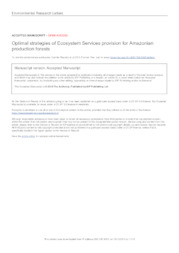Optimal strategies of Ecosystem Services provision for Amazonian production forests.
Optimal strategies of Ecosystem Services provision for Amazonian production forests.
Author(s): PIPONIOT, C.; RUTISHAUSER, E.; DERROIRE, G.; PUTZ, F. E.; SIST, P.; WEST, T. A. P.; DESCROIX, L.; GUEDES, M. C.; CORONADO, E. N. H.; KANASHIRO, M.; FREITAS, L. J. M. de; OLIVEIRA, M. V. N. d'; PEÑA-CLAROS, M.; RODNEY, K.; RUSCHEL, A. R.; SOUZA, C. R. de; VIDAL, E.; WORTEL, V.; HÉRAULT, B.
Summary: Although tropical forests harbour most of the terrestrial carbon and biological diversity on Earth they continue to be deforested or degraded at high rates. In Amazonia, the largest tropical forest on Earth, a sixth of the remaining natural forests is formally dedicated to timber extraction through selective logging. Reconciling timber extraction with the provision of other ecosystem services (ES) remains a major challenge for forest managers and policy makers. This study applies a spatial optimisation of logging in Amazonian production forests to analyse potential trade-offs between timber extraction and recovery, carbon storage, and biodiversity conservation. Current logging regulations with unique cutting cycles result in sub-optimal ES-use efficiency. Long-term timber provision would require the adoption of a land-sharing strategy that involves extensive low-intensity logging, although high transport and road-building costs might make this approach economically unattractive. By contrast, retention of carbon and biodiversity would be enhanced by a land-sparing strategy restricting high-intensive logging to designated areas such as the outer fringes of the region. Depending on management goals and societal demands, either choice will substantially in uence the future of Amazonian forests. Overall, our results highlight the need for reevaluation of current logging regulations and regional cooperation among Amazonian countries to enhance coherent and trans-boundary forest management.
Publication year: 2019
Types of publication: Journal article
Unit: Embrapa Amapá
Keywords: Administração Florestal, Amazonia, Biodiversidade, Biodiversity, Carbon, Carbono, Ecosystem services, Estoque, Exploração seletiva, Extração da Madeira, Multicriteria optimisation, Otimização multicritério, Oxigênio, Produção de madeira, Selective logging, Serviços de ecossistemas, Timber production
Observation
Some of Embrapa's publications are published as ePub files. To read them, use or download one of the following free software options to your computer or mobile device. Android: Google Play Books; IOS: iBooks; Windows and Linux: Calibre.
Access other publications
Access the Agricultural Research Database (BDPA) to consult Embrapa's full library collection and records.
Visit Embrapa Bookstore to purchase books and other publications sold by Embrapa.

